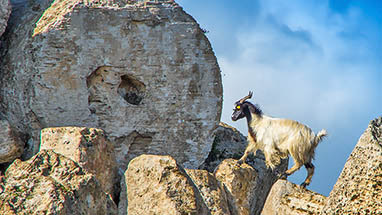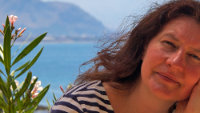The History of Sicily in Two Minutes Flat

Even people who think history is boring find Sicilian history interesting. History can explain everything we see around us and, in Sicily, the stories are usually amazing and intriguing.
You may wonder, for example, what that goat is doing [photo, right] in the ruins of the ancient Greek City of Selinute. Perhaps you'd like to know why Palermo Cathedral has part of the Koran carved into its wall. Almost every tourist who visits Sicily for their holidays wants to understand how the Mafia got started.
Historians fill whole books with answers to these questions, but we will take you on a journey through 2000 years in just two minutes. If you do want to go into more detail, we recommend the Wikipedia article on Sicilian history.
There have been very few times in Sicily's history when the island ruled itself. Sicilians have almost always been part of someone else's empire.
The various foreign "occupiers" of Sicily are often used to explain how Sicily evolved, but also as scapegoats to blame for the island's lack of modern progress and for the nurturing of the Mafia. Whilst there is some truth in this argument, it has also been used as an excuse for sitting about in denial. Nowadays the Sicilians themselves are tackling and beating the Mafia.
| Period | Geopolitical Classification | Typical Characteristics | |
|---|---|---|---|
| 700 B.C. - 200 B.C. | Ancient Greek period | Central point of the Greek Mediterranean |
|
| 200 B.C. - 500 A.D. | Ancient Roman period | Province in the Roman Empire |
|
| 500 A.D. - 800 A.D. | Byzantine Era | Part of the Holy Roman Empire (Ruled from Byzantium, now Istanbul) |
|
| 800 A.D. - 1100 A.D. | Arabic period | Aghlabid Emirate, then the Fatimid Caliphate – both North African empires |
|
| 1100 - 1300 | Normans and Hohenstaufen | Norman territory (The Normans conquered widely, but without a unified empire) |
|
| 1300 - 1860 | French period, Spanish period, Bourbon period. (The Bourbons were French but also ruled parts of Spain and Italy.) | Kingdom of the two Sicilies |
|
| 1860 - 1970 | Italian Nation | Disputed Italian territory |
|
| 1970 - today | Republic of Italy | Italy/European Union |
|
| The periods given are approximate | |||
Author

The information on this site comes from our Sicily expert Britta Bohn.
Britta has been dealing with daily life and life in Sicily for over 20 years.
Don't miss any of her tips! Subscribe to our free Newsletter:
An Invitation
Dear friends of Sicily, we invite you to join the Facebook Group "Trip-Tipp Sicily". Find answers to all your questions and discover exclusive tips for your trip to Sicily from those who have already made the journey and those who already know the island from the inside out: